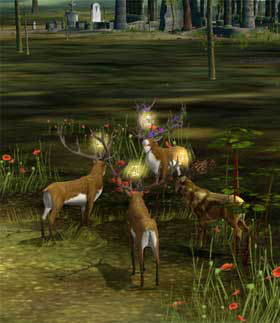 Recently in the gaming blog Gamersutra, Ernest Adams questions why aren’t there highbrow video games.” His article comes one month after an Esquire article, where Chuck Klosterman wondered why isn’t there good video game criticism and makes the claim that video games needs its own Lester Bangs. As the video game market grows, it is not surprising that fans and advocates of gaming will want to form to grow and mature as well.
Recently in the gaming blog Gamersutra, Ernest Adams questions why aren’t there highbrow video games.” His article comes one month after an Esquire article, where Chuck Klosterman wondered why isn’t there good video game criticism and makes the claim that video games needs its own Lester Bangs. As the video game market grows, it is not surprising that fans and advocates of gaming will want to form to grow and mature as well.
Adams’ call for “highbrow” games is rooted in a desire to add creditability and legitimacy to video games. As someone who has dedicated his career to making and writing about video games, the never-ending criticism about the violence in games by various groups looking for easy political targets must be frustrating to endure. I can appreciate the motivations behind Adam’s conclusion, however, his description of highbrow video games is ultimately too narrowly defined and overlooks impressive experiments of video games.
I hesitate to even try to deem games “high” or “low” because the terms are not that useful. Adams specifically points out that the films he aspires video games to emulate are not “art films,” which he describes as a “short low-budget titles filled with impenetrable weirdness.” Therefore, his definition of highbrow edge towards the problematic “I know it when I see it” definitions of art. Further, we can gather insight on culture and ourselves by interacting will both high and low culture and valuing one form over another is problematic.
From his description of a highbrow video game, I think what Adams is really asking for is better interactive narratives in gaming. He alludes to the films of Ishmail Merchant and James Ivory, who are best known for adopting the novels of E.M. Forester, often with screenwriter Ruth Prawer Jhabvala. Their films tend to be beautiful, well crafted analyses of class. Although, they are not generally know for pushing the boundaries of film.
Last year, Adams gave a talk which he published on his website, in which he assesses the state of interactive narrative. It provides more insight on his train of thought. In it, one of his references in video game scholarship is Janet Murray’s Hamlet on the Holodeck which uses a theatrical frame of reference in postulating the future of interactive narrative. Also, Adams offers a model of a “structured” approach to the narrative of video games and reveals that he is particularly wedded to the idea of single player games over the shared gaming experience of MMORPGs which are increasingly popular. In his current essay, his description of states that the highbrow video game “would reward close attention and playing more than once.” This implies that he still leans towards single player role playing games in his conceptualization of highbrow games.
However, video games that are pushing the form in more “artistic” ways are occurring outside the bounds of single player game. For example, we-make-money-not-art reported on The Endless Forest, which is a gorgeous MMORPG in which players assume the identity of a deer. Developed by the Belgian studio Tale of Tales, The Endless Forest has an elegant interface and darkly rich art direction. Although it lacks an explicit narrative, the gameplay engages users without the typical violence and sexually charged themes of many games. The Endless Forest limits the use of language. Therefore, it does not include a chat function and players are “named” with pictograms rather than words. However, as more of these kinds of games are created, they are unlikely to lessen the criticism of the negative social effects of video games.
As for criticism, the notion of elevating video game criticism to a higher form is rather ironic, as it comes at the same time when the New York Times critic A.O. Scott finds himself defending film criticism. While not a music critic, Scott describes the critics’ predicament that often panned movies are still hugh box offices successes. Media critics want the new and interesting, which is somewhat expected if it is your job to watch and write about movies, music, or video games everyday. Their standards are quite different from the typical audience member. Lester Bangs was a polarizing figure, who wanted to raise the standards of writing on music. He appeared at a time when people were ready for similar standards. It may be that a critical mass of audience for a similar kind of criticism for gaming is beginning to emerge.
As previously stated, most gamers will still want “mainstream” titles. Because games are expensive, they will still rely on criticism which Klosterman dismissives as “customer advice.” That is, many gamers, if not most, will still mostly be interested in reading reviews which describe gameplay, graphics and sound design, rather than thematic and issues of meaning. Many gamers don’t like the academic scholarly writing on video games, which is in adbundance, but is not what Klosterman wants to read. We learned about their attitutdes in initial reactions and comments posted across the gaming blogosphere about our project “GAM3R 7H30RY.” It’s not clear to me what is bad about gaming publications serving the desires of the video game playing community.
 My guess is that both boundary pushing video games and criticism will be begin to get more exposure fairly soon. For the actual video games, I would look towards Europe and Asia, where more government funding exists for developing these kinds of endeavors. I don’t expect many of the big gaming companies in the US to create experimental games of this nature. Although, they might in the future, after the proven economic viability of them. In that, major movie studios started funding more smaller films after they saw successful crossover of films of the Merchant Ivory variety. Although, Rockstar (the maker of Grand Theft Auto) have the upcoming and already controversial game Bully, where you must navigate a boarding school as a new student. It was described by the New York TImes as having, “an open world for the players to explore, tightly defined and memorable characters, a strong story line, [and] high-end voice acting,” which is precisely what Adams call for in his article.
My guess is that both boundary pushing video games and criticism will be begin to get more exposure fairly soon. For the actual video games, I would look towards Europe and Asia, where more government funding exists for developing these kinds of endeavors. I don’t expect many of the big gaming companies in the US to create experimental games of this nature. Although, they might in the future, after the proven economic viability of them. In that, major movie studios started funding more smaller films after they saw successful crossover of films of the Merchant Ivory variety. Although, Rockstar (the maker of Grand Theft Auto) have the upcoming and already controversial game Bully, where you must navigate a boarding school as a new student. It was described by the New York TImes as having, “an open world for the players to explore, tightly defined and memorable characters, a strong story line, [and] high-end voice acting,” which is precisely what Adams call for in his article.
Regardless of who moves video games and its coverage further, it’s bound to happen. Although, these new forms may not look exactly has Adams and Klosterman describe or wish. Media takes time to evolve, just compare the “highbrow” television series the HBO produces as compared to rather “lowbrow” television from the 50s. (I will admit that I don’t prefer one over the other.) For a great example of how a medium transforms the perspective of an artist, see Scott McCloud’s description of the movement from comic book fan to student to professional to genre pushing pioneer in Understanding Comics. If someone really wants to write video game criticism in the style of Lester Bangs, then the current low barriers of entry to electronic self-publishing allows her to do so. Creating video games, of course, requires a lot more resources. However, in closing, Adams states, “maybe I’ll design one myself, just for the fun of it.”
if:book
A Project of the Institute for the Future of the Book
